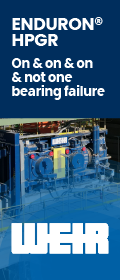 With rapid advances in technology and emission legislation, not only the choice of technology but also the choice of engine supplier has become an important issue for equipment manufacturers for the construction industry. In 2011, Volvo Penta and Sandvik Mining and Construction signed a cooperation agreement with the goal to enhance the long-term competitiveness of Sandvik’s products. To date, Sandvik has introduced Volvo Penta engines in several models from its product lines for crushers, drilling rigs, loaders and haulers. “Volvo Penta has been receptive to our requirements during the development and we are pleased with the engineering support they provide us”, says Chris Jobburn, Senior Product Support Engineer at Sandvik Construction.
With rapid advances in technology and emission legislation, not only the choice of technology but also the choice of engine supplier has become an important issue for equipment manufacturers for the construction industry. In 2011, Volvo Penta and Sandvik Mining and Construction signed a cooperation agreement with the goal to enhance the long-term competitiveness of Sandvik’s products. To date, Sandvik has introduced Volvo Penta engines in several models from its product lines for crushers, drilling rigs, loaders and haulers. “Volvo Penta has been receptive to our requirements during the development and we are pleased with the engineering support they provide us”, says Chris Jobburn, Senior Product Support Engineer at Sandvik Construction.
Installing after-treatment systems have proven to be a major issue for many equipment builders in the US and the EU. For Sandvik engineers, the SCR technology has not been a major challenge: “This is just another regular engine installation”, commented Seppo Karhu, Manager for Engine Installations at Sandvik Mining, after the first-ever loader with SCR for mining and tunnelling applications had been developed. “With the SCR technology, ventilation rates become so low that it is no longer toxic emissions, but CO2 or fuel consumption that sets the limits. And the Volvo engines have low fuel consumption”, says Olli Koivisto, Global Product Line Manager for Load and Haul at Sandvik Mining.
In 2011, Volvo Penta was one of the first diesel engine manufacturers to receive stage 3B and Tier 4i certificates for its entire engine line-up. For many years these engines have been successfully proven for use in the demanding underground mining segment. Now, the same engines are also certified by MSHA and CANMET. Volvo Penta has received Mine Safety and Health Administration (MSHA) as well as CANMET-MMSL certification for its 13L interim Tier 4 diesel engines. The 13L is the first engine to receive the certification. The 350-550 hp, TAD1360 / 61 / 62 / 63 / 64 / 65VE-series of diesel engines offers ventilation rates that are among the lowest in the industry for the given power category. The ventilation rate is around 30 CFM/hp which is considerably lower than traditional diesel engines used in mines today.










